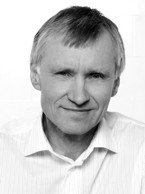In Economy, Everything Moves Up and Down Unavoidably *
Since mid-1990s, Estonia has experienced a successful process of integration to the global economy.
Hand-in-hand with political integration to the European Union (and to NATO as well), the credibility of Estonia as an attractive place for investors, in particular for foreign direct investments but also for local investors, has increased rapidly. Accession to the EU and NATO in 2004 accelerated these processes, e.g. the net liabilities of commercial banks to foreign credit institutions increased by more than 18 times in 2003–2008. The growth of GDP that was based largely on the inflow of foreign capital was 32 per cent in same period. Unfortunately, such rapid (statistical) growth (“The Economist” ironically, 10 March 2007: “your money, my growth”) relied on domestic market oriented branches like construction, retail trade, real estate business.
The features of overheating became more and more apparent. This process can be measured by the explosive growth of wages (during 2007, more than 20 per cent average; y-to-y) and by the increase of inflation (from January to September 2008, more than 10 per cent; y-to-y). Labour market turned into a full employment market. Total increase in the number of employed persons amounted to 49 700 in 2005–2008, of whom 44 700 persons were employed in construction and trade. The first attempt to access the euro zone was not successful.
Expansive growth supported by foreign capital inflow turned out to be unsustainable. In the first quarter of 2008, GDP decreased by 2.2 per cent (y-to-y). There was an expectation of “a soft landing”. In autumn, after the spreading of the global financial crisis, it became clear that instead of “a soft landing” Estonia, like Latvia and Lithuania, had to face a serious economic contraction. The inflow of new capital to the economy stopped and the main export markets collapsed. The import demand of Finland decreased by 30.0 per cent, that of Sweden by 24.7 per cent, that of Latvia by 37.4 per cent, that of Russia by 33.9 per cent, that of Germany by 17.5 per cent and that of Lithuania by 37.9 per cent in 2009 (measured in euro). The number of employed persons started to fall and unemployment began to rise. At the same time, deflationary developments in European economies reached Estonia and gave the country the real opportunity to fulfil Maastricht inflation criteria for accession to euro zone.
After having decreased for nine quarters, GDP started to grow in annual figures in the second quarter of 2010, like in most European countries. The recovery of demand in foreign markets, above all in Nordic markets, was followed by a rapid growth of industrial output and exports. The number of employed persons started to increase and unemployment started to decrease. The GDP growth of 6.7 per cent (y-to-y) in the fourth quarter of 2010 was the second-fastest among EU countries (Sweden being the fastest). It is relevant to point out that the amplitude of the quarterly fall and growth rates of GDP was 23.3 per cent in Estonia in the period of 2008–2010, which was the highest among EU countries. On the other hand, this verified the thesis that the peaks and bottoms of the cycles may be sharper and entering and exiting the crises may be faster in case of currency board arrangement compared to classical monetary policy.
*The statistical data of the article is as of 20 May 2011.
